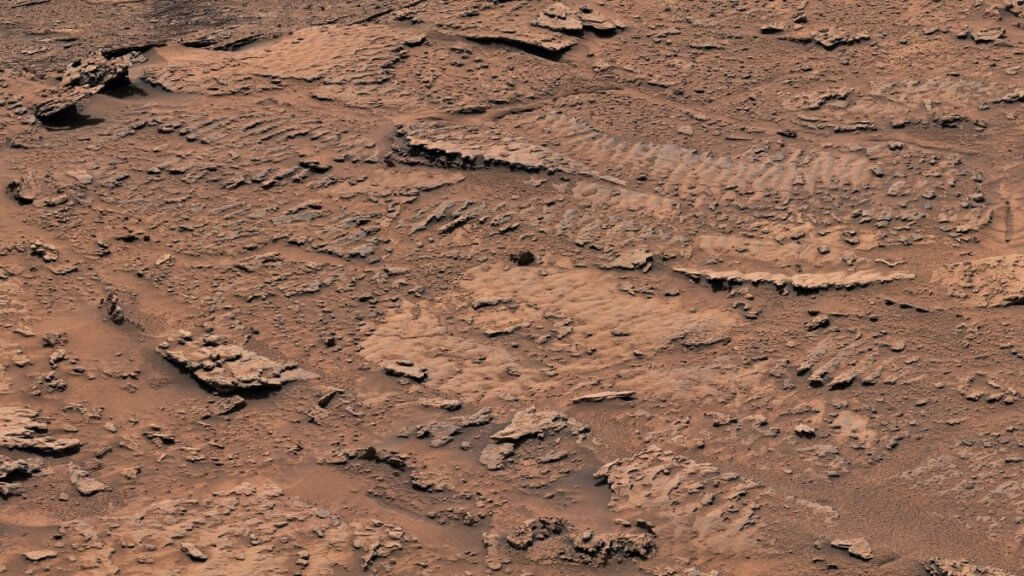A NASA rover exploring the foothills of a Martian mountain has found rippled rocks, offering scientists the clearest evidence yet of ancient water waves on the Red Planet.
Curiosity, a car-size robot that has been rumbling over Mars for a decade, took photos of the peculiar geology in mid-December(Opens in a new tab). The rocks are like the undulating patterns one might find when the tide reels the ocean back from a beach, revealing wobbly tracks on the temporarily exposed sand.
Mission scientists say waves of water lapping on the surface of a shallow lake created these grooves, perhaps billions of years ago. The movement on top churned up sediment from the bottom, they suspect, forming the combed texture.
“We climbed through thousands of feet of lake deposits and never saw evidence like this,” said Ashwin Vasavada, Curiosity’s project scientist at NASA’s Jet Propulsion Laboratory, in a statement(Opens in a new tab). “Now we found it in a place we expected to be dry.”
“We climbed through thousands of feet of lake deposits and never saw evidence like this.”
For years researchers have found signs that Mars used to be bathed in creeks and lakes. Martian water chiseled sinuous river beds and deep ravines into the ground, now hollowed out and dusty. In the first year(Opens in a new tab) of Curiosity’s expedition, it sent home pictures of a stream bed, eroded and dry, with bountiful round pebbles, similar to those formed on Earth from flowing water.
The obsessive search for past water on Mars, a frozen desert, is a quest to prove the Red Planet was once wet, warm, and more Earth-like. Lakes and oceans could have been a key ingredient for supporting primitive Martian life, once upon a time, but this doesn’t outright mean the environment was habitable. By exploring former water sites, NASA hopes to find evidence of ancient microbial life.
Still, geologists can learn a lot from these rocks with water imprints, which can also be found on Earth in petrified seabeds from eons ago. The spacing between ripples, for example, is an indicator of the water’s depth and the size of the waves that molded them.
Tweet may have been deleted
(opens in a new tab)
(Opens in a new tab)
Want more science and tech news delivered straight to your inbox? Sign up for Mashable’s Top Stories newsletter today.
The rover has slowly climbed the slope of Mount Sharp, a three-mile-high mountain once ribboned with streams, since 2014. Creeping through the desolate alien wilderness, Curiosity is exploring an environment that could have been hospitable to tiny microorganisms, if any ever inhabited Mars.
The robot found the rippled rocks about a half-mile up the mountain on a feature dubbed “Marker Band(Opens in a new tab),” a dark, thin layer of rock sandwiched between lighter layers. Scientists first saw this natural landmark in orbiter images years before the rover even launched into space.
But the mission team never dreamed Curiosity would find more evidence of an ancient lake in the rover’s current whereabouts, a region thought to be formed when Mars was becoming drier. The area is chock full of salty minerals(Opens in a new tab), perhaps remnants of water that was drying to a trickle.

Credit: NASA / JPL-Caltech / MSSS
Marker Band has been a tough nut to crack — almost literally. Its rocky layer is so hard, Curiosity has failed at drilling through it to get a sample. Panoramic images taken by the robot show a couple of its recent failed attempts (seen in the video toward the top of this story) to penetrate the rocks.
“But we might find a softer spot on the road ahead,” Vasavada said in the narrated video.
Next, the rover will head to a wind-carved valley to check out a pile of boulders and debris that experts think were washed down the mountain in a landslide billions of years ago. There, scientists hope to spot ancient evidence of flowing water.

